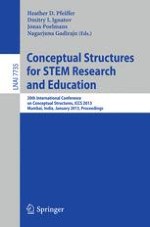This book constitutes the proceedings of the 20th International Conference on Conceptual Structures, ICCS 2013, held in Mumbai, India, in January 2013. The 22 full papers presented were carefully reviewed and selected from 43 submissions for inclusion in the book. The volume also contains 3 invited talks. ICCS focuses on the useful representation and analysis of conceptual knowledge with research and business applications. It advances the theory and practice in connecting the user's conceptual approach to problem solving with the formal structures that computer applications need to bring their productivity to bear. Conceptual structures (CS) represent a family of approaches that builds on the successes of artificial intelligence, business intelligence, computational linguistics, conceptual modeling, information and Web technologies, user modeling, and knowledge management.
